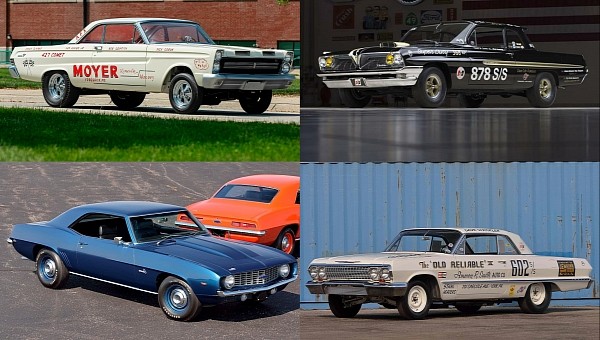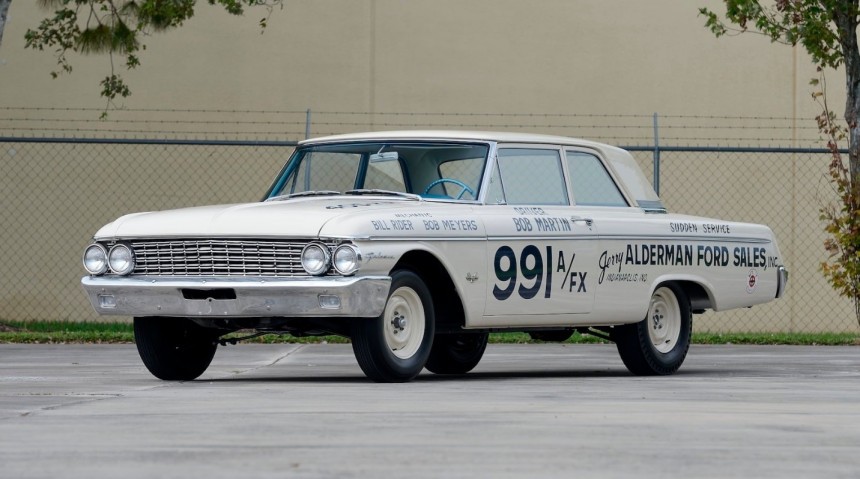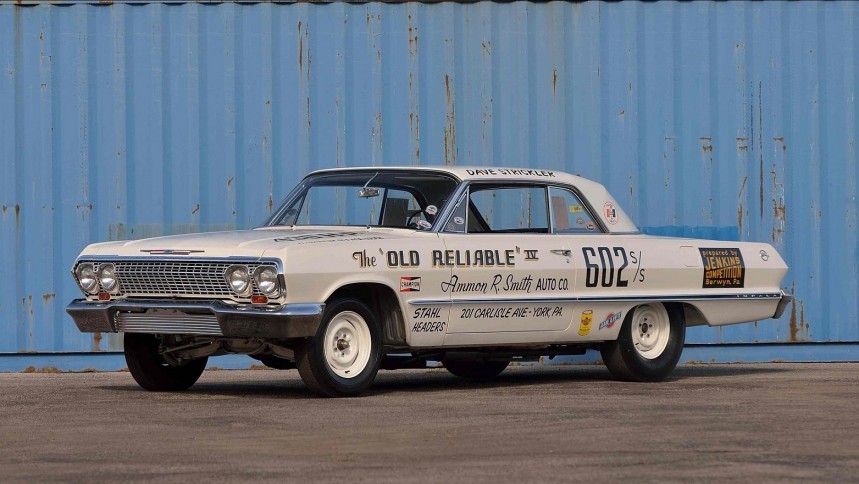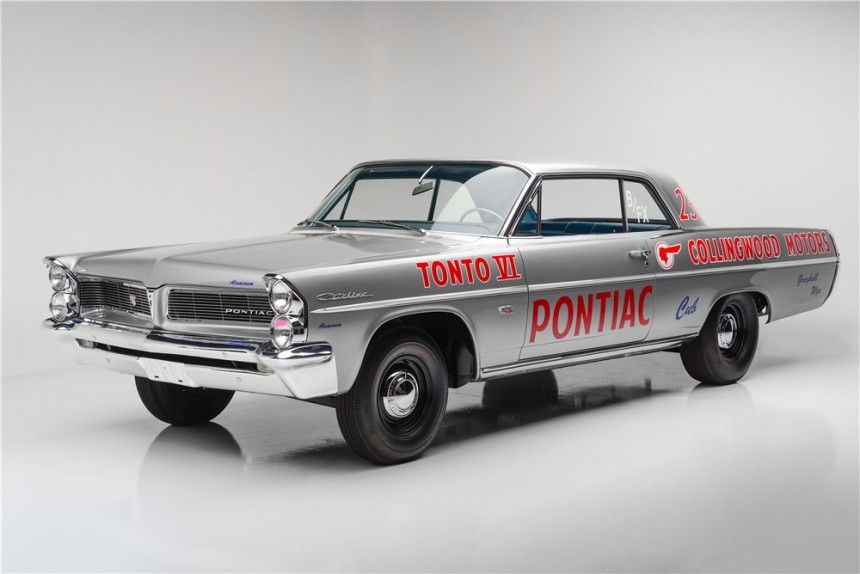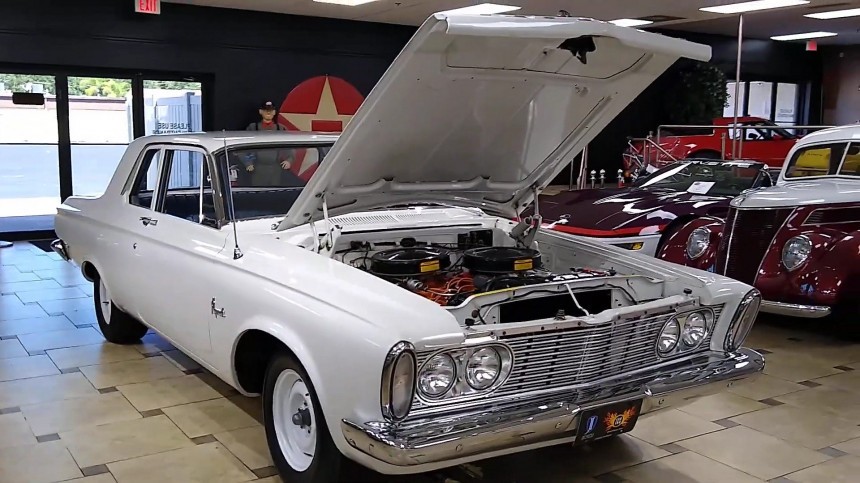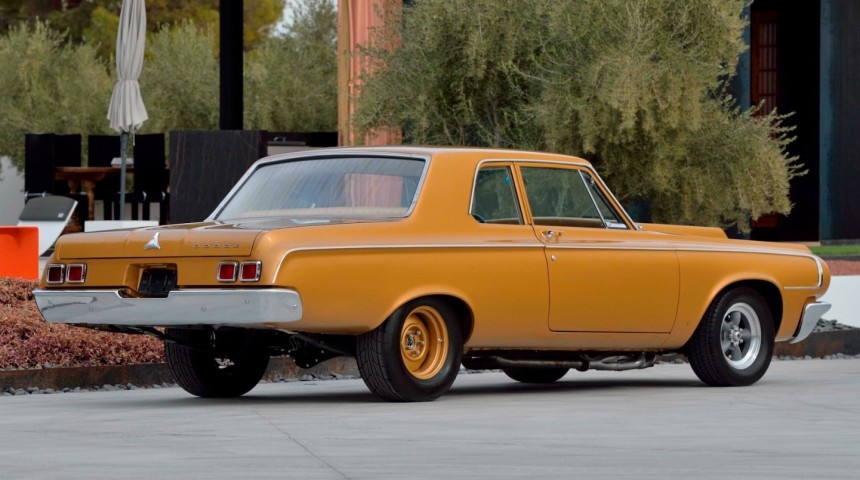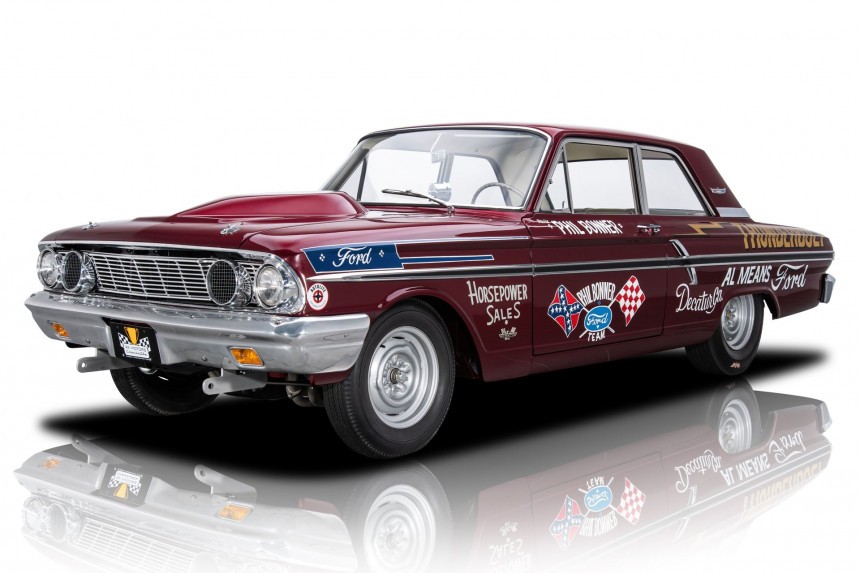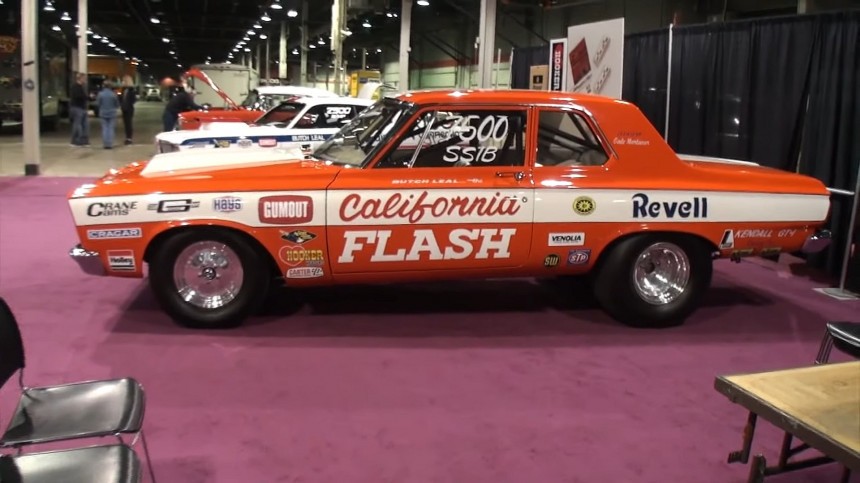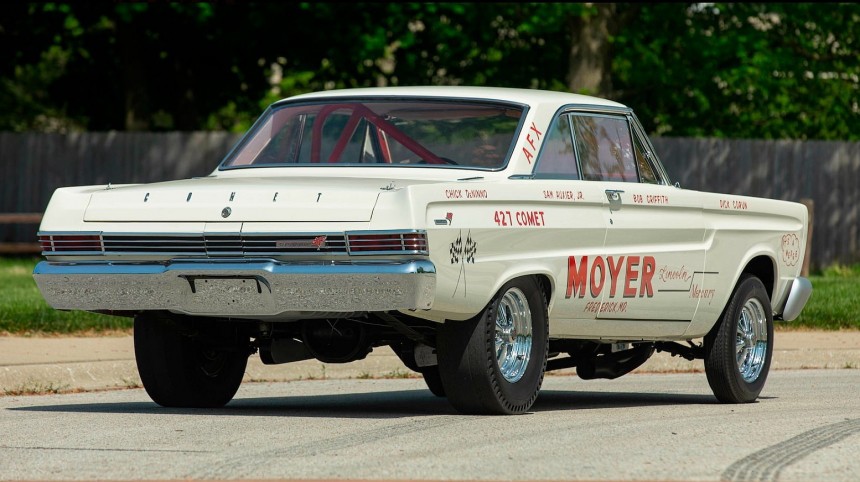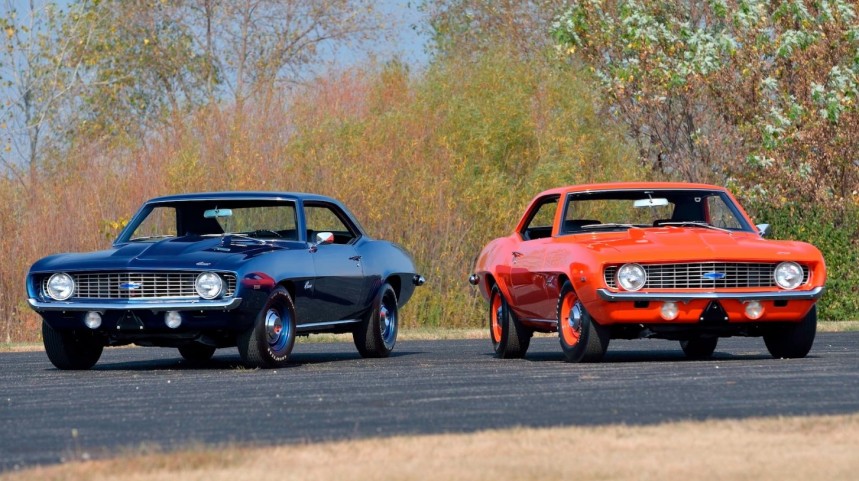It's 2023 and we're still debating whether the muscle car era began with the Oldsmobile Rocket 88 in 1949 or the Pontiac GTO in 1964. But what I do know for a fact is that the popularity and performance of muscle cars exploded in the early 1960s thanks to drag racing and NASCAR.
The "win on Sunday, sell on Monday" motto had become an extremely heated affair, and Detroit automakers engaged in a drag racing war that lasted for almost a decade and spawned some of the greatest factory-built dragsters out there.
Due to NHRA regulations at the time, these drag strip monsters had to share most components with their regular-production counterparts. As a result, most of them left the factory as unassuming sleepers. Some are more iconic than others, but they're all spectacular in their own right. Here are 10 of them.
The 1964 Thunderbolt is arguably the most iconic factory-built dragster sporting the blue oval emblem. But the beefed-up Fairlane came to be thanks to the Galaxie Lightweight, Ford's first fully-blown factory dragster.
Developed in response to Chevrolet's 409-powered Impala, the Galaxie Lightweight left the Dearborn Steel Tubing shop with loads of fiberglass and aluminum components and devoid of convenience features such as radio, heater, body filler, and sound-deadening materials.
More importantly, it was fitted with a bespoke 406-cubic-inch (6.7-liter) V8 with two four-barrel carburetors and an aluminum intake. Good for 405 horsepower, it was Ford's quickest and most powerful vehicle at the time. Only 11 were built.
The Chevrolet Z11 wasn't Chevrolet's first factory dragster, but it's the meanest incarnation of the Impala. Unlike the SS 409 before it, the Z11 got a larger 427-cubic-inch (7.0-liter) V8 with a long list of race-ready parts and a compression ratio of 13.5:1. Rated at 430 horsepower, the mill was slightly more potent than the 426 HEMI that hit the drag racing scene in 1964.
Stripped off its radio, heater, sound-deadening material, and front sway bar, the Z11 also ditched many steel body panels for aluminum. Some 300 pounds (136 kg) lighter than the regular Impala, the Z11 was the dragster to beat in 1963. Chevy made only 57 of them and fewer than 50 are still around today.
Very similar to the Impala Z11, the Catalina Super Duty was also born in 1963, when Pontiac dropped the race-spec 421-cubic-inch (6.9-liter) V8 Super Duty into its full-size hardtop. Naturally, the engine became eligible for the NHRA and quickly found its way into lightweight Catalinas.
Known as the "Swiss Cheese" Catalinas due to having about 130 holes in the frames for weight-saving purposes, these Super Duty racers also sported aluminum parts and were devoid of non-essential equipment. Given to key drag racing teams, the "Swiss Cheese" Catalinas covered the quarter-mile in less than 13 seconds.
It was 1962 and Chrysler had yet to introduce the mighty 426-cubic-inch (7.0-liter) HEMI V8, but Mopars were already dominating the drag strip thanks to a different RB-based powerplant. I'm talking about the Max Wedge, a 413-cubic-inch (6.8-liter) V8 that generated as much as 420 horsepower.
Built in limited quantities until 1964, the Max Wedge found its way into a handful of Mopars, spawning the now-iconic Dodge Ramchargers and Plymouth Super Stocks. Chrysler took things up a notch by putting together lightweight versions of the Plymouth Savoy and Dodge 330, a pair of unassuming sleepers that morphed into rare collectibles.
Enlarged to 426 cubic inches, the Max Wedge was phased out in 1964, but Chrysler didn't stop making factory dragsters. With the more modern and reliable HEMI now rolling out the assembly line, the Mopar Super Stock racers were simply updated and sent back to the drag strip to burn more rubber.
But not before Chrysler removed their rear seats and relocated the batteries in their trunks. And they looked just as unassuming as their spiritual predecessors in factory paint.
While not quite as prolific as Chrysler, Ford made a huge splash in 1964 with the Thunderbolt. Essentially a Fairlane with a massive 427-cubic-inch (7.0-liter) V8 crammed under the hood, the Thunderbolt succeeded where the Galaxie Lightweight failed, winning the NHRA Top Stock crown and the Manufacturers' Cup.
Officially rated at 425 horsepower, the Thunderbolt was actually capable of more than that, with independent tests revealing it was, in fact, a 500-horsepower monster. The story goes that the Thunderbolt turned out to be too light for the NHRA in the initial configuration, so Ford had to put one of the steel bumpers back on the car.
I know, the Thunderbolt is not exactly a sleeper, but I just had to include it on this list.
And we're back into Mopar territory with yet another pair of HEMI-powered rigs. Launched a year before the street-spec HEMI became available to the general public, the A990 package turned both the Plymouth Belvedere and the Dodge Coronet into drag-ready muscle cars.
Just like their spiritual predecessors from 1964, these Mopars were also lighter than their regular dealership counterparts. However, because the NHRA banned fiberglass and aluminum components for Super Stock cars following the 1964 season, Chrysler lightened the cars through acid dipping, which reduced body panel thickness by up to 60%. The mirrors, the heater, and the rear seat were also deleted from the package.
As for the aluminum-loaded 426 HEMI, while officially rated at 425 horsepower, the mill was actually capable of around 550 horses. Holy moly! In 1967, Chrysler rolled out a new pair of Coronet / Belvedere HEMI dragsters known as R023s.
You know drag racing was a big thing in the 1960s simply because Mercury, Ford's luxury-oriented division, also jumped on the bandwagon. The company selected the small Falcon-based Comet for its drag racing program, pairing it with a massive 427 V8 engine related to that fitted in the Ford Thunderbolt.
To avoid competing with the latter in the Super Stock class, the Comet Cyclone was prepped for the A/FX series, which it dominated with drivers like Ronnie Sox, Don Nicholson, and Wild Bill Shrewsberry behind the wheel. Only 50 cars were made, so it's the rarest Mercury wearing a "Comet" badge.
Born as a pony car in 1964, the Barracuda morphed into a fully-fledged muscle car in 1970. Redesigned with a more aggressive exterior, the 'Cuda also got the 426 HEMI V8 for a couple of years. But did you know that the more mundane second-gen version was also available with the mighty 426? It happened in 1968, when Plymouth dropped the HEMI in 50 cars developed for drag-racing duty.
This rare and not-so-famous Barracuda co-developed with Hurst Performance is called the BO29. Aimed at Super Stock racing, it needed less than 11 seconds to cover the quarter-mile. Dodge offered an identical package on the Dart. Codenamed LO23, it was built in 80 units. Both cars were somewhat road-legal, but came with no-warranty disclaimers.
A more familiar "face," the ZL1 was one of two special COPO muscle cars offered by Chevrolet in 1969. Originally ordered by Don Yenko, the COPO 427 was essentially a Camaro fitted with the solid-lifter L72 V8 sourced from the Chevrolet Corvette. The ZL1, on the other hand, was conceived by drag racer Dick Harrell and commissioned by the Fred Gibb Chevrolet dealership with a more special, all-aluminum 427-cubic-inch V8.
Created specifically for drag racing, the mill delivered 430 horsepower (obviously underrated) and turned the Camaro into one of the quickest factory-built muscle cars at the time. And because it was devoid of stripes and fitted with color-keyed steel wheels, it was also rather unassuming. It was quite expensive, though, and Gibbs had trouble selling all 69 examples he ordered.
Due to NHRA regulations at the time, these drag strip monsters had to share most components with their regular-production counterparts. As a result, most of them left the factory as unassuming sleepers. Some are more iconic than others, but they're all spectacular in their own right. Here are 10 of them.
1962 Ford Galaxie 500 Lightweight
Developed in response to Chevrolet's 409-powered Impala, the Galaxie Lightweight left the Dearborn Steel Tubing shop with loads of fiberglass and aluminum components and devoid of convenience features such as radio, heater, body filler, and sound-deadening materials.
More importantly, it was fitted with a bespoke 406-cubic-inch (6.7-liter) V8 with two four-barrel carburetors and an aluminum intake. Good for 405 horsepower, it was Ford's quickest and most powerful vehicle at the time. Only 11 were built.
1963 Chevrolet Impala Z11
Stripped off its radio, heater, sound-deadening material, and front sway bar, the Z11 also ditched many steel body panels for aluminum. Some 300 pounds (136 kg) lighter than the regular Impala, the Z11 was the dragster to beat in 1963. Chevy made only 57 of them and fewer than 50 are still around today.
1963 Pontiac Catalina Super Duty "Swiss Cheese"
Known as the "Swiss Cheese" Catalinas due to having about 130 holes in the frames for weight-saving purposes, these Super Duty racers also sported aluminum parts and were devoid of non-essential equipment. Given to key drag racing teams, the "Swiss Cheese" Catalinas covered the quarter-mile in less than 13 seconds.
1963 Plymouth Savoy / Dodge 330 Max Wedge Lightweight
Built in limited quantities until 1964, the Max Wedge found its way into a handful of Mopars, spawning the now-iconic Dodge Ramchargers and Plymouth Super Stocks. Chrysler took things up a notch by putting together lightweight versions of the Plymouth Savoy and Dodge 330, a pair of unassuming sleepers that morphed into rare collectibles.
1964 Plymouth Savoy / Dodge 330 HEMI Super Stock
But not before Chrysler removed their rear seats and relocated the batteries in their trunks. And they looked just as unassuming as their spiritual predecessors in factory paint.
1964 Ford Fairlane Thunderbolt
Officially rated at 425 horsepower, the Thunderbolt was actually capable of more than that, with independent tests revealing it was, in fact, a 500-horsepower monster. The story goes that the Thunderbolt turned out to be too light for the NHRA in the initial configuration, so Ford had to put one of the steel bumpers back on the car.
I know, the Thunderbolt is not exactly a sleeper, but I just had to include it on this list.
1965 Dodge Coronet / Plymouth Belvedere HEMI A990
Just like their spiritual predecessors from 1964, these Mopars were also lighter than their regular dealership counterparts. However, because the NHRA banned fiberglass and aluminum components for Super Stock cars following the 1964 season, Chrysler lightened the cars through acid dipping, which reduced body panel thickness by up to 60%. The mirrors, the heater, and the rear seat were also deleted from the package.
As for the aluminum-loaded 426 HEMI, while officially rated at 425 horsepower, the mill was actually capable of around 550 horses. Holy moly! In 1967, Chrysler rolled out a new pair of Coronet / Belvedere HEMI dragsters known as R023s.
1965 Mercury Comet A/FX Lightweight
To avoid competing with the latter in the Super Stock class, the Comet Cyclone was prepped for the A/FX series, which it dominated with drivers like Ronnie Sox, Don Nicholson, and Wild Bill Shrewsberry behind the wheel. Only 50 cars were made, so it's the rarest Mercury wearing a "Comet" badge.
1968 Plymouth Barracuda HEMI B029 / Dodge Dart HEMI L023
This rare and not-so-famous Barracuda co-developed with Hurst Performance is called the BO29. Aimed at Super Stock racing, it needed less than 11 seconds to cover the quarter-mile. Dodge offered an identical package on the Dart. Codenamed LO23, it was built in 80 units. Both cars were somewhat road-legal, but came with no-warranty disclaimers.
1969 Chevrolet COPO Camaro ZL1
Created specifically for drag racing, the mill delivered 430 horsepower (obviously underrated) and turned the Camaro into one of the quickest factory-built muscle cars at the time. And because it was devoid of stripes and fitted with color-keyed steel wheels, it was also rather unassuming. It was quite expensive, though, and Gibbs had trouble selling all 69 examples he ordered.
